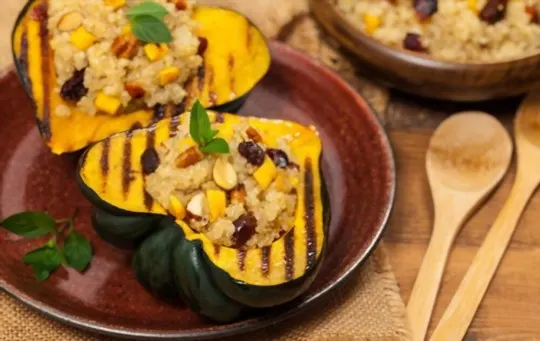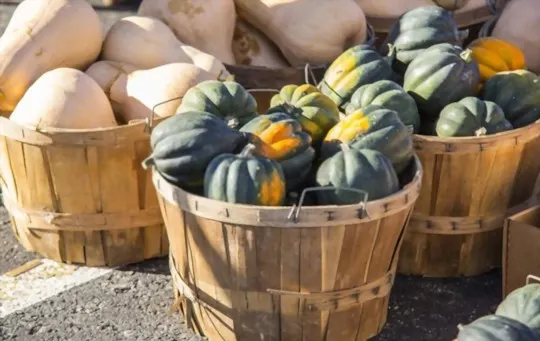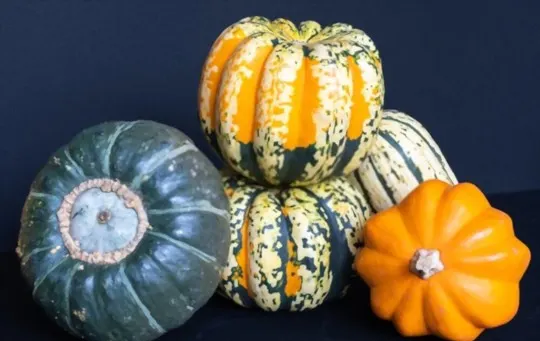Are you curious about what acorn squash tastes like? You’re not alone.
Acorn squash is a popular winter vegetable with a unique flavor.
It’s sweet yet nutty, and can be enjoyed in a variety of dishes.
In this article, we’ll explore everything you need to know about acorn squash and its delicious taste.
From roasting to steaming to pureeing – there are many different ways to enjoy this delicious vegetable.
But no matter how you choose to prepare your acorn squash ─ try adding herbs like thyme or rosemary ─ as they pair wonderfully with this mild yet flavorful vegetable.
What is Acorn Squash?

Acorn squash is a winter squash variety, part of the Cucurbitaceae family.
A hard-shelled member of the gourd family, acorn squash is relatively small in size and typically shaped like an elongated bell.
Its exterior ranges from dark green through yellow to orange, with pale beige stripes and light speckles.
When cut open, its flesh is bright orange-yellow in color and firm with a mildly sweet flavor.
Acorn squash can vary greatly in size from 1 ½ to 7 pounds; smaller acorns are generally more tender than larger ones.
Acorn squash has several benefits in terms of nutrition; it’s low in fat and cholesterol but high in dietary fiber, vitamin C and carotenoids such as lutein and zeaxanthin — all important for eye health.
It also contains good amounts of B vitamins like folate, niacin and thiamine along with other minerals such as potassium, calcium and magnesium.
When it comes to taste, acorn squash has a mild sweetness that makes it ideal for basics like soups or stews but its versatility allows you to use it as a side dish or main course too.
Roasting brings out its natural sweetness as well as a nuttiness that pairs well with savory flavors such as spicier herbs or garlic-infused oil touches.
You can mash it up either peeled or unpeeled with butter or just enjoy the flavor after tossing cubes through olive oil with some sea salt before baking for an easy autumn side dish.
What Does Acorn Squash Taste Like?

Acorn squash is a common winter squash variety that gets its name from its shape—it resembles an acorn, with a ridged and bulbous exterior.
Its flavor is buttery and slightly sweet, and it can be eaten cooked or raw.
The most common types of acorn squash are dark green with orange streaks.
There are also other varieties available, such as orange-skinned ‘Table Queen’ and yellow-skinned ‘Sweet Mama’ acorn squash.
When cooked, acorn squash has a mildly sweet, nutty flavor and a tender-firm texture.
Roasting acorn squash intensifies the sweetness while keeping it firm on the inside.
You can also bake, steam, or microwave it as an alternative to roasting.
This winter vegetable is excellent when topped with brown butter or balsamic glaze or pureed into soups and stews for added creaminess.
Thanks to its nutty sweetness, acorn squash makes for an ideal side dish for pork ribs or turkey dinners during festive occasions such as Thanksgiving and Christmas feasts.
This colorful vegetable pairs well with herbs such as thyme, rosemary, garlic and sage—along with tart flavors like oranges or apples in more adventurous recipes.
Factors that Affect the Taste of Acorn Squash

The flavor of any acorn squash can be influenced by several factors, including its variety, growing conditions, and proper cooking technique.
Acorn squash has a sweet yet nutty taste that is similar to that of butternut squash but slightly milder.
The variety of the acorn squash will determine its flavor profile and sweetness.
Some varieties are sweeter than others and have various levels of nuttiness in the flavor.
For a pronounced nutty flavor, try varieties like Table Ace, Honeyboat Delicata and Sweet Dumpling.
For a sweeter-tasting squash with a milder flavoring, look for choices such as Golden Hubbard or Dunja F1 Hybrid.
The growing conditions can also affect the taste of an acorn squash.
The squash will be the sweetest when grown in warm temperatures with plenty of sun and rich soil full of nutrition such as nitrogen and phosphorus.
Too much water can also reduce flavor complexity by diluting sugars present in the vegetable, resulting in a blander taste overall even if it results in a larger individual product.
Finally, proper cooking technique plays an important role in bringing out the best qualities in any organic food item.
Research additional tips on how to cook acorn squash properly – this will allow you to maximize its natural sweetness while avoiding overcooking which can result in mushy texture and dulled flavors without enough nutrients retained from cooking water or fats used to prepare it with.
1 – Ripeness
The ripeness of acorn squash can have an effect on the taste and texture.
Squash that is picked when still green and unripe, or over ripe, will not be as sweet as squash picked when at peak ripeness.
To check if the acorn squash is ready to eat, look for any discoloration or mold on the outside rind.
If the rind appears dull in color then it may be overly mature and won’t taste as good.
If you look closely at your squash before eating it, you may notice that ripe acorn squash has an orange-yellow hue to its skin with a hint of yellow-green.
When selecting acorn squash at the grocery store, avoid buying specimens that have large bruises since these will also affect flavor and texture negatively.
It’s important to note that all squashes must be washed before consuming due to their high pesticide content – but use caution when washing as the rind can easily be punctured.
Once cooked and seasoned with salt, pepper or sugar, nutmeg and even cream or butter, you’ll find that acorn squash has a very mild sweet flavor – much like other winter squashes such as butternut squash and kabocha.
2 – Cooking Methods
Acorn squash is versatile and can be used in a variety of recipes for sweet or savory dishes.
Before cooking, the squash should be cleaned and prepped by cutting into wedges or slots then discarding the seeds.
Acorn squash can be prepared in several different ways to bring out its delectable sweet, nutty flavor.
The most common ways to cook acorn squash are baking, boiling, microwaving, roasting and steaming.
Each cooking method requires slightly different preparation instructions and may result in different textures due to differences in cooking times.
Baking: The recipe calls for preheating the oven at 375°F (190°C).
Slice the acorn squash into wedges, remove the seeds and place cut-side down onto a greased baking sheet.
Spread butter over the tops then bake for 25-35 minutes until tender when pierced with a fork.
A sprinkle of cinnamon can also be added before baking to give it an extra hint of sweetness.
Boiling: Cut into slices, strips or cubes depending on desired texture; smaller pieces will cook faster than larger ones so plan accordingly.
Bring water to a boil in large pot over medium-high heat; add a pinch of salt then add acorn squash pieces to boiling water.
Boil for 3-5 minutes, stirring occasionally (cooking times will vary depending on size) until they become fork-tender but not mushy.
Remove from heat; drain excess liquid using colander and cool before serving or using in other recipes.
Microwaving: Cut into even slices no more than 1/2 inch thick then remove seeds if necessary (or leave them on if desired).
Arrange slices onto microwave safe plate sprayed with nonstick cooking spray; season with salt and pepper as preferred plus optional spices such as nutmeg or cinnamon if desired.
Cover dish tightly with microwave safe plastic wrap making sure edges are completely sealed from air exposure otherwise it could burn during microwaving process.
Cook on high 3 minutes per slice; let stand 1 minute after cooking before serving/enjoying warm.
3 – Seasonings and Flavorings
When it comes to the flavor of acorn squash, its mild and sweet taste stands out amongst other varieties.
Its taste is subtly sweet and nutty, with a hint of natural butter.
Adding various seasonings and flavorings to acorn squash can help enhance its nature-given taste, providing a much more delicious experience with every bite.
The following seasonings are wonderful for creating that perfectly balanced flavor for any given dish:
- Honey.
- Cinnamon.
- Ginger.
- Nutmeg.
- Garlic powder.
- Allspice.
- Basil.
- Sage.
- Rosemary.
Selecting the right combination of herbs and spices will allow for the creation of a unique flavor that truly accentuates the nature of acorn squash.
Amongst these spices, adding some sweeter ingredients like honey or brown sugar can provide extra sweetness while cinnamon and nutmeg can add a nice spicy kick.
If you’d like to really bring out the roasted qualities of acorn squash, using thyme or garlic powder is perfect.
Experimenting with different spice combinations can help to bring out all of the complex flavors within this vegetable.
How to Cook Acorn Squash to Enhance its Flavor

Acorn squash has a subtle sweet flavor that can be enhanced and accentuated by cooking it in different ways.
To make the most out of this squash variety, roasting is our go-to method.
It caramelizes the inner flesh of the squash, giving it an extra sweetness and smokiness that can’t be achieved with any other cooking method.
Try pairing acorn squash with sweet spices like cinnamon, nutmeg and brown sugar for an even more flavorful dish.
When roasting acorn squash, cut it in half horizontally (top to bottom) so that you’re not dealing with a round shape.
Brush each half lightly with oil or melted butter, season both the exterior and inner flesh of the squash and place it cut-side down on a baking sheet lined with parchment paper.
Bake at 350°F for around 45 minutes or until fork-tender – you can test this by poking a fork into the outer skin of the squash after 30 minutes then again when there’s only 10 minutes left on the timer.
When fully cooked, you can serve it as is or top it off with chopped bacon, cranberries and nuts for extra crunch.
Nutritional Value and Health Benefits of Acorn Squash
Acorn squash is an incredibly nutritious and versatile squash.
With a naturally sweet flavor, it can be enjoyed raw or cooked, and is available year-round.
Its outer skin has a beautiful dark green color with yellow stripes running up and down its ridges.
Inside the acorn squash, its pale yellow flesh is filled with edible seeds that can be roasted and eaten just like pumpkin seeds.
Acorn squash offers an abundance of health benefits.
It contains plenty of fiber, helping to regulate digestion.
It also provides essential vitamins and minerals like vitamin C, vitamin B6, potassium, copper and manganese.
In addition to these vitamins and minerals, acorn squash contains a unique type of antioxidant called carotenoids which help to protect the body against free radicals.
Acorn squash also provides anti-inflammatory benefits due to its high levels of omega-3 fatty acids, as well as its low glycemic index which helps stabilize blood sugar levels.
Where to Buy Acorn Squash and How to Store It?

When shopping for acorn squash, pick a heavy squash with an intact cap.
The outside should be dull in color and have few to no blemishes.
Once home, store uncut squash in a cool dry place and it should last up to a month.
Cut squash will keep in the refrigerator for several days and can also be frozen after cooking.
Acorn squash can be found year-round at most grocery stores, farmer’s markets, or even local farms and is usually pretty easy to find.
It’s also becoming more popular as people expand their food palate, so it may be easier to find now than ever before.
Prices typically fall anywhere from as low as $0.35/pound all the way up to $1/pound depending on the store and general location.
Conclusion
In conclusion, acorn squash has a pleasant sweet taste and is relatively easy to prepare.
The flesh of the squash can be roasted, cubed or pureed and added to any number of recipes, both savory and sweet.
It can also be enjoyed raw as a tasty snack or salad ingredient.
Acorn squash provides an excellent source of vitamins A and C, potassium, fiber and other essential nutrients that may help promote good health overall.
Acorn squash is a versatile vegetable with a pleasant sweetness that makes it very enjoyable for both cooking and eating.

What Does Acorn Squash Taste Like? A Comprehensive Guide
Ingredients
- Acorn squash
- Ingredients from your selected recipes
Instructions
- Select your favorite ingredient from the range available in this article.
- Collect all the necessary items to make the recipe.
- Use the instructions provided to prepare a delicious dish in 30 minutes or less.

Carrie is a food writer and editor with more than 15 years of experience. She has worked for some of the biggest names in the food industry, including Bon Appétit, Food & Wine, and Martha Stewart Living.
As the Editor in Chief of IntroChicago.com, Carrie oversees all of the content on the site. She also manages the team of contributing writers and editors, who help to create delicious recipes, helpful tips, and informative articles that you’ll find on the site.
A native of the Chicago area, Carrie is passionate about all things food. She loves trying new restaurants and experimenting with new recipes in her kitchen. She’s also a graduate of the Culinary Institute of America, so she knows a thing or two about food!
